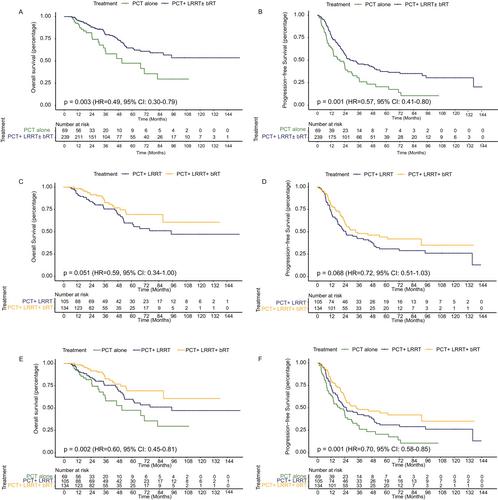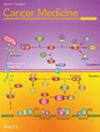Whether Primary Bone-Only Oligometastatic Nasopharyngeal Carcinoma Patients Benefit From Radiotherapy to the Bones on the Basis of Palliative Chemotherapy Plus Locoregional Radiotherapy?—A Large-Cohort Retrospective Study
Abstract
Objectives
Whether to perform local radiotherapy on metastatic bone for primary bone-only oligometastatic nasopharyngeal carcinoma (NPC) patients remains unclear. Therefore, we analyzed the treatment methods and their survival and developed a prognostic model to predict outcomes and guide personalized treatment.
Materials and Methods
We studied 308 primary bone-only oligometastatic NPC patients who were treated with either palliative chemotherapy (PCT) alone, PCT combined with locoregional radiotherapy (LRRT), or PCT, LRRT, and radiotherapy to metastatic bones (bRT). The primary endpoint was overall survival (OS). Cox regression was utilized to identify independent prognostic factors, leading to the construction of a nomogram model. Patients were stratified into two risk groups based on median prognostic scores, and treatment modalities were compared using log-rank test while employing the inverse probability of treatment weighting (IPTW) to balance baseline characteristics and adjust for sample size differences between risk groups.
Results
The best OS was observed in the group treated with PCT, LRRT, and bRT (HR = 0.60, 95% CI: 0.45–0.81, p = 0.002). Multivariable analysis revealed that age, N stage, pre-treatment levels of LDH, and EBV DNA were independent prognostic factors for OS. In total, 155 patients were in low-risk group while 153 were in high-risk group. Before and after IPTW, the high-risk group benefited from the PCT, LRRT, and bRT regimen (adjusted HR = 0.53, 95% CI: 0.42–0.67, p < 0.001; unadjusted HR = 0.59, 95% CI: 0.42–0.83, p = 0.007), while the low-risk group did not (adjusted HR = 0.79, 95% CI: 0.56–1.11, p = 0.345; unadjusted HR = 0.65, 95% CI: 0.37–1.14, p = 0.309).
Conclusion
Best outcomes of the whole cohort were seen with PCT + LRRT + bRT. Our study identified age, N stage, pre-treatment LDH levels, and EBV DNA levels as independent prognostic factors for OS. The high-risk group demonstrated a longer OS when treated with PCT + LRRT + bRT, whereas the low-risk group did not benefit from the combinatorial treatment.


 求助内容:
求助内容: 应助结果提醒方式:
应助结果提醒方式:


